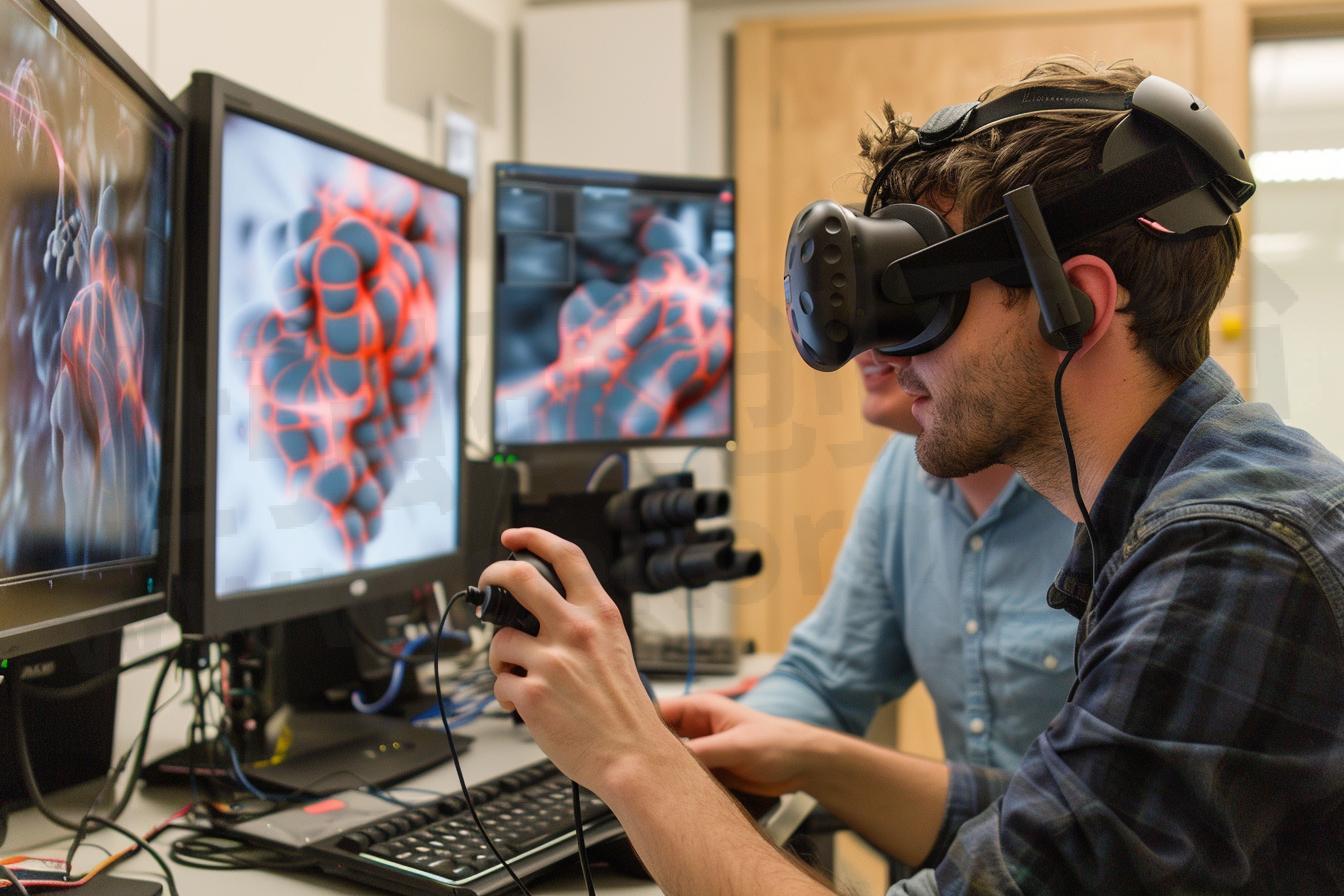University Haptic Labs Leading the Way in Haptic Research

Haptics is a rapidly growing field. As the demand for more immersive and intuitive user interfaces increases, so does the demand for more in-depth research and studies in this fascinating area. Many universities worldwide are quickly recognizing this need, and have not only begun to offer specialized courses about haptics, but have also established dedicated haptics labs. Their research primarily focuses on human-computer tactile interaction, with use cases in areas such as robotics, automotive, virtual and augmented reality, and medical.

Below, we've collected a few of the university haptic labs worldwide that conduct research within this growing technological field.
1. University of Southern California – HaRVI lab
The University of Southern California's Haptics Robotics and Virtual Interaction (HaRVI) Laboratory is a haptics lab dedicated to exploring human interaction with the environment via touch. The lab's primary focus is on human perception, to develop interactions that authentically replicate the sensations felt during real-world physical interactions.
The HaRVI Lab is directed by Dr. Heather Culbertson.
2. University of California Santa Barbara – RE TOUCH Lab
The RE TOUCH Lab at the University of California Santa Barbara is an interdisciplinary lab that explores the mechanisms of perception and action. They design haptic devices, create soft or wearable robots, investigate new material technology, and advance applications in VR and health.
The lab is directed by Professor Yon Visell, and is a part of the Media Arts and Technology Program, as well as the Departments of Electrical and Computer Engineering, and Mechanical Engineering at UCSB.
3. University of Chicago – Human Computer Integration Lab
The Human Computer Integration Lab at the University of Chicago focuses on engineering interactive devices that directly integrate with the user’s body, superseding traditional wearable interfaces. Their research explores human-computer integration, using EMS on their interactive devices to create enhanced VR experiences and interactive learning without the bulkiness of robotic exoskeletons. Moreover, they borrow parts of the user’s body as input/output hardware, which results in the implementation of a novel interaction model.
The lab is led by Professor Pedro Lopes at the Computer Science Department of the University of Chicago.
4. Carleton University – Creative Interactions Lab
The Creative Interactions Lab at Carleton University also focuses on human-computer interaction. They aim to develop interaction methods with new user interfaces through the use of software and hardware design, development, and evaluation. Currently, their research is on flexible displays, exploring their distinctive features to develop novel interaction methods and enhance the current touch capabilities of rigid screens.
The Creative Interactions lab is currently led by Dr. Audrey Girourard.
5. University of Waterloo – Haptic Experience Lab
The Haptic Experience (HX) Lab at the University of Waterloo is a team of researchers dedicated to the comprehensive study of haptic systems. They delve into these systems extensively and on a large scale, developing theoretical tools and producing research to make haptic technology as accessible as any other medium. They aim to develop a range of haptic computing tools to aid in the design, implementation, and research of haptic technology, which they will utilize to carry out groundbreaking studies in the field of haptics.
The lab is highly interdisciplinary, spanning faculties from Engineering to Arts, and is directed by Professor Oliver Schneider.
6. University of British Columbia – SPIN Lab
The Sensory Perception & Interaction Research Group (SPIN) research group at the University of British Columbia designs and creates innovative, touch-based user interactions to address real-world problems. The group focuses on human perception and emotion, emphasizing both the functionality and design process of these interfaces and exploring how these interactions will be perceived by users. The application of their work spans various areas including wearable technology, robotics, furniture, therapeutic tools, and car interiors.
The Research group is directed by Professor Karon MacLean.
7. McGill University – Shared Reality Lab
The Shared Reality Lab at McGill University is committed to developing interaction systems that incorporate both real and virtual data. The lab works with audio, video, and haptic technologies, as well as mixed reality and mobile computing to facilitate and enhance both human-computer and computer-mediated human interaction. Their current projects include creating avatars for elderly engagement, audio-haptic experiences for blind users, immersive walking experiences, and futuristic flight deck designs.
The lab is currently directed by Dr. Jeremy Cooperstock.
8. KAIST – Interactive Robotics Systems (IRIS) Laboratory
The Interactive Robotics Systems (IRIS) Laboratory at KAIST in South Korea is committed to enhancing human lives through the development of cutting-edge technologies. They research haptics and telerobotics in order to design interactive robotic systems, specifically for field robotics in sectors such as disaster response, construction, mining, and agriculture.
The lab is currently led by Dr. Jee-Hwan Ryu.
9. University of Tokyo – Tachi Lab
The Tachi Lab at the University of Tokyo is a global leader in the fields of Virtual Reality, Human Augmentation, and Telexistence. The lab aims to develop human-centered that enables natural interaction between humans and machines such as robots and computers. Their research spans topics such as haptics, RPT, robotics, and autosteroscopy, in order to design human-machine interaction akin to handling natural objects.
The Tachi Lab is currently led by Dr. Susumu Tachi.
10. King's College London – CoRE Haptics Lab
The CoRe Haptics Lab at King's College London is focused on the development, design, and evaluation of innovative haptic systems to augment human perception. Their focus is on applications such as Minimally Invasive Surgery (MIS) and Human Robot Interaction (HRI). Some of their projects include designing methods to reintroduce partial haptic feedback and mimicking the physical interaction during surgery, and developing a robot that can guide firefighters in a low-light visibility environment.
The CoRe Haptics Lab is currently led by Dr. Helge A. Wurdemann.
11. Delft University of Technology – Delft Haptics Lab
The Delft Haptics Lab, part of the Human-Robot Interaction group within the Department of Cognitive Robotics at Delft University of Technology, is dedicated to improving human-robot interaction through the development of haptic interfaces. The lab's mission is to understand how humans use force when performing dynamic control tasks and use this knowledge to improve physical interaction with machines. The team conducts research and education in haptic and human-robot interaction across various practical applications, collaborating with different companies across the world to bring their research to market. The lab also aims to stimulate societal discussions about human-robot interaction through media and outreach activities.
The Delft Haptics Lab is currently led by Professor David A. Abbinik.
- +1 Like
- Add to Favorites
Recommend
- Understanding Haptics: A Journey through the History and Evolution of Haptic Technology
- Haptic Motors Clustered Haptic Arrays by TITAN Haptics Clusters Unlock New Possibilities
- Haptics in XR, Apple’s Hand Tracking and DIY Haptics Peripherals
- Why Haptics? Unveiling the Benefits and Applications of Haptic Technology
- Steering the Future: The Role of Haptics in Automobiles
- Google’s Open Source Vibrotactile Haptic Platform: Combining Feedback and Sensing
- Exploring Advanced Haptic Interactive Technologies with Dr. Ivan Poupyrev
- What is Haptics? Perspectives from Top Sources
This document is provided by Sekorm Platform for VIP exclusive service. The copyright is owned by Sekorm. Without authorization, any medias, websites or individual are not allowed to reprint. When authorizing the reprint, the link of www.sekorm.com must be indicated.






























































































































































































































































































































































































































































































































































































































































































































































































































































































